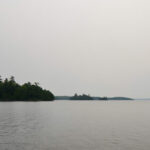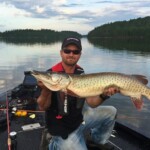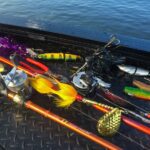This show is about Esox Masquinongy, the Muskellunge, the largest member of the Pike family, and its ability to capture the imagination of so many committed fishermen. This is one of the most physically demanding activities a recreational angler can get into. It can be described in two words: Muskie Mystique.
Clearly, there’s something about the Eagle Lake Muskie that makes its fishermen behave like knights on a quest for the Holy Grail. And for generations, it has been said that this grail swims in Eagle Lake.
Here are some factors that add to the aura of this fish:
First: They’re huge—the #1 apex freshwater predator in North America.
Second: There are not a lot of them, and they’re very elusive, relative to our other native species.
Third: They tantalize with their fussy eating, sometimes following a lure right to the boat while they decide whether or not to eat it.
That’s what this Fish’n Canada episode is all about: fishing, or should I say searching for muskie.
When you look at Eagle Lake on a map, the topography practically screams muskie. Gouged out of the earth by retreating glaciers 10,000 years ago, its 658 kilometres of rugged shoreline shows hundreds of bays, points, inlets and channels, providing countless opportunities to bag a trophy no matter which way the wind blows. It’s a relatively large lake, over 255 square kilometres, and contains 490 islands with their own little bays and points. Potential is everywhere.
Eagle Lake is located in northwestern Ontario in what’s known as the Unorganized Kenora District. This district covers 35 percent of Ontario’s land mass, but holds only 0.05 percent of its population. That’s one person for every five square kilometres.
Basically, if you want to fish solo for a while, this is the place to go.
The only people here on any kind of regular basis are the people who work the lodges, curious anglers and their friends, and a handful of hardcore muskie fishermen. One thing everyone can agree upon is that it’s beautiful wilderness. It’s a must-see, whether you fish or not.
Pete decided before the trip that he was not going to troll for these Muskies. “I wanted to catch ’em the hard way,” he explains. “By casting!” But, he wasn’t going to be stupid about it, either. Eagle Lake is a big body of water, and if he wanted to get on them quick, he was going to need an expert on all things muskie.
That expertise would be coming from Ron Buth, the head guide and previous owner of Eagle Lake Island Lodge—Pete’s beautiful home for the duration of his trip. By telling Pete where to go and what to look for, Ron (with his forty-one years of knowledge) would essentially shrink the size of this formidable lake into much smaller fishing zones.
From there, Pete would use his Garmin units, find likely spots, and saturate the area with a variety of baits and presentations.
MASQUINONGY
Muskies have a low reproductive rate and slow growth, rendering populations highly vulnerable to over-fishing. This is why you see such strict size and creel limits for this magnificent creature. There’s a 54 inch limit here on these fish. But it’s an unnecessary rule in Pete’s opinion. He says, “All muskies should be released!”
The so-lunar tables promised good fishing this particular week, but remember: The muskie, being a dominant predator crossed with a fussy eater, don’t always read the so-lunar tables very well.
By the end of the first day, Pete was totally frustrated, working his mind through the Muskie Mystique. “This is the fish of 10,000 casts,” he reminds viewers. “Throwing huge muskie baits with heavy line and heavier rods, with no hits all day, beat me up physically and emotionally.”
Day two: back to the grind again. After a good night’s sleep with dreams of a giant smashing a bait and thrashing boat-side, a muskie angler is raring to go—with hopes, of course, that great dream becomes a reality.
“I’d tried a variety of baits so far,” Pete explains. “Inline bucktails were my main choice, followed closely by a Yamamoto swimbait, as well as a couple of diving crankbaits resembling a Walleye. The muskie are big here and a one to two-pound Walleye makes a great meal. So don’t think your bait is too big.”
Cast after cast after cast after cast… again and again…
“I was wondering what a guy has to do to hook up with one of these beasts of the north!”
Not willing to give up completely, Pete took a break from the muskie and went out Walleye fishing. “I figured it would give my arms, as well as my mind, a bit of a rest.”
The Walleye were hanging tight to cover and even they were slow to bite. “I was actually getting a little nervous because I was thinking, What am I doing wrong here? Thankfully I wasn’t alone. Ron Buth spoke to some fishermen from a few other lodges, and nobody was catching any muskie. We’re all pretty much at a loss trying to figure out what’s going on, and my time here is fading rapidly.”
THE LAST DAY ON EAGLE
On his final full day on the water, Pete couldn’t believe that he’d gone so long on the fabled Eagle Lake without a single muskie hook-up. “I had some follows,” says Pete. “But no takers.”
Muskie fishing isn’t always as tough as it was on this particular outing. Take last year’s trip to the French River with Ang, for instance. As Pete recalls, “We each landed a fifty-plus incher, and both of them came in the first half hour of two consecutive mornings.
“I know for a fact that the same can happen here on Eagle. It’s all about timing, and mine was unfortunately bad.”
For his last evening on Eagle, Pete slid into an isolated weedy bay, and Pike started hitting. “I hoped this would be a good omen in that if one member of the Esox family is active, maybe their bigger cousins would be, too. Problem was, it was getting dark. If I had another full day to fish, this hunger strike might be ending. But I had to get out of there the next morning. I was scheduled to arrive at the Nipigon River for my next shoot.”
LAST CHANCE
Pete did have one more sliver of opportunity: Get up at first light, bomb over to a nearby rock point, fish for maybe an hour and then trailer the boat and move on. Pete would have to hope that one desperate hour could make up for the past three days.
“The morning was perfect,” Pete remembers. “It was calm and warm. I was using a big inline bucktail with two massive size-ten blades whomping in the water. If that point didn’t produce right there, right then, I’d be going home empty handed. No show for the team waiting back at the studio.”
With the big bucktail thumping just under the surface, Pete had a great fish literally nose up to the bait—but didn’t take. He was just too close not to eat it!
“I got to thinking maybe it was the lure’s fault, so I switched to a smaller inline black bucktail with a single number six blade, and I tipped it with just the tail of a white Yamamoto swimbait. Something to give it a bit of flare and a target at the hook. Maybe this little finesse move with a colour change and a smaller lure would entice him.”
Pete recast to where he thought the fish might’ve gone. Lo and behold, the muskie pounded the bait. Pete rammed the hook home with a big 8’ heavy duty Carrot Styx rod with 65-pound braid. The hook was definitely set.
“Something happened over those days to shut these fish down, and I’m still scratching my head over it,” Pete admits.
But there you have it in a nutshell, folks: the Muskie Mystique. They’re on, they’re off, they follow, but don’t strike. But they’re always huge!
“Thank you Eagle Lake. I’ll definitely be back!”
MUSKIE INFO
A muskie’s diet consists mostly of fish, but can also include frogs, ducklings, snakes, mice, mink, baby muskrats, and beavers, as well as small birds. The mouth is large with many long, shark-like teeth. Muskies will attempt to take their prey head first, sometimes with a single gulp. They will consume prey up to 30 percent of their total length. Early in the season, they tend to prefer smaller bait due to slow metabolism, while larger baits are preferred in fall as preparation for winter.
Adult Muskellunge are apex predators, residing at the top of a food chain. Only humans pose a threat to an adult muskie—although juveniles are often eaten by other muskies, Northern Pike, Bass, and birds of prey.
Eagle Lake has all three different colour patterns of the Muskellunge: Clear, Spotted and Barred. Pete is confident he had follows from all three during his time on the lake.
The Canadian record muskie, caught by Kenneth John O’Brian, weighed an astounding 65 pounds. It was 58 inches long and had a girth of 30.5 inches. It was caught on October 16, 1988, in Georgian Bay.
You may have heard of the Tiger Muskie, but the fact is it’s not a pure Muskellunge; it’s a cross between a muskie and a Northern Pike, and they, too, live in Eagle Lake. They’re quite rare, however, and very sought after.
The term “Figure 8” is synonymous with the muskie world. Essentially, it is a continuation of a cast once there is no more line to reel in. Muskellunge are notorious for following a lure to the boat and oftentimes a Figure 8 will trigger a strike.
Each and every cast should have at least a portion of a Figure 8 before the bait is pulled from the water, just in case a muskie is following in the depths just out of sight.
SPECIAL THANKS












